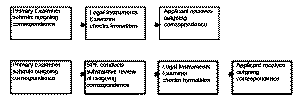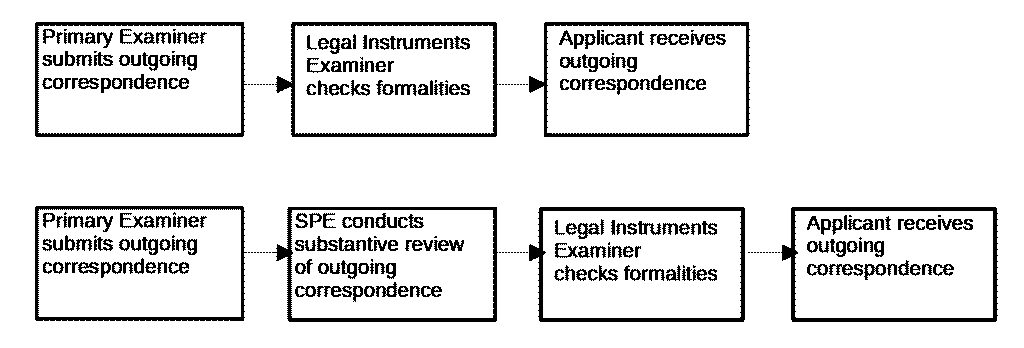
(Note: this blog article is the first in a series of articles that will describe recent changes within the USPTO that have big effects upon applicants and upon people within the USPTO.)
For decades it has been the case that when a primary Examiner submits a piece of outgoing correspondence, the applicant would receive it soon after — typically within a couple of days. But within recent months, it has been commonplace to see long delays before the applicant receives the outgoing correspondence. How bad are the delays, and what is the cause of the delays?
The brief answer is, these days it is commonplace for an applicant to have to wait a week or two weeks or more to receive outgoing correspondence from the Patent Office. A first reason for this is that the USPTO has lost some of its Legal Instruments Examiners in recent months. A second reason for this is that USPTO management has decided that in addition to the other things that SPEs (Supervisory Patent Examiners) are required to do, they are now required to review every piece of outgoing correspondence before it gets sent to the applicant.
First I should explain what a SPE is, which requires me to explain a bit about the Examining Corps within the USPTO.
There are about 8500 Patent Examiners at the USPTO. They are grouped into nine Technology Centers, each of which is responsible for examining patent applications in a particular technical field. Within each Technology Center there are a number of Art Units, each typically containing 10-15 Examiners. The total number of Art Units is around 500, each managed by a Supervisory Patent Examiner or SPE.
Patent Examiners are, of course, technically trained and they draw upon their technical training when examining patent applications for novelty and unobviousness and other qualifications for patentability. The Patent Examiners comprise what is referred to as “the Examining Corps”.
Each Technology Center has a number of LIEs (Legal Instruments Examiners), who carry out a variety of formalities tasks. Unlike a Patent Examiner, who carries out substantive examination of patent applications, the LIE is not technically trained and is tasked with non-substantive formal matters.
Within the Examining Corps, some Examiners have achieved an advanced position called a “Primary Examiner”. When you look at a piece of outgoing correspondence, you might see that it is signed by two people or by one person. If the Examiner who wrote the correspondence was not yet a Primary Examiner, then the Examiner is required to get a signoff from their SPE (or from some other Primary Examiner) before submitting it to be communicated outside the USPTO. On the other hand, if the Examiner who wrote the correspondence was a Primary Examiner, then no supervisor signoff is needed.
Another thing that is affected by “Primary” status is that if a non-Primary Examiner is to conduct an interview with an applicant, the Examiner is required to arrange for the Examiner’s SPE (or for some other Primary Examiner) to attend at the interview. In contrast, a Primary Examiner is permitted to conduct an applicant interview alone.
This now brings us to the focus of this blog article. Why is it that in recent months there are serious delays in outgoing correspondence from the USPTO, and what is the cause of the delays? To explain this, we can start by recalling how outgoing correspondence used to flow, before the changes of recent months. Let’s assume for sake of discussion that the Examiner on a particular application happens to be a Primary Examiner or PE. And the PE writes a piece of outgoing correspondence. (This might be an Office Action, for example, or it might be a Notice of Allowance.) In legacy workflow, the PE clicks “submit” and the correspondence lands on the desk of an LIE. The LIE checks some formalities (typically within 1 or 2 or 3 days) and then clicks “send” to send the correspondence to the applicant.

But a first thing that has changed in recent months is that USPTO management has decided that the SPE is now required to carry out a substantive review of each piece of outgoing correspondence generated by the Examiners who answer to that SPE. Only after the SPE has completed the substantive review does the correspondence land on the desk of an LIE. One practical consequence of this extra step in outgoing correspondence workflow is the injection of anywhere from a few days to some weeks of delay while the substantive review takes place.
A second thing that has changed in recent months is that there are fewer LIEs in recent months then there were previously. Some have departed from the USPTO in response to the “fork in the road” initiative (blog article). Others have been laid off. The LIEs that remain are no longer represented by a bargaining unit due to the recent elimination of most bargaining units at the USPTO because of an Administration determination that the work of the USPTO is “national security” work. One practical consequence of these changes is that each of the remaining LIEs has more work to do, and so it takes longer.
The alert reader will want to know how I know about these things. In my own work serving patent clients, there have been several times in recent months when, for example, I would talk with an Examiner and the Examiner would agree to do an Examiner’s Amendment and allow the case, and what would happen next is … nothing … for two or three weeks. And I would place a followup call to the Examiner and the Examiner would say that he or she really did allow the case on that day. I have by now had quite a few conversations with people at the USPTO (both Examiners and members of management) who have shared various developments in an informal way.
Another information source is the wealth of discussion in the Patent Practice listserv and the e-Trademarks listserv, each of which has a membership of many hundreds of bright and experienced and generous practitioners.
Yet another learning opportunity arose because (as will be recalled from blog article and blog article) I recently had the honor to teach three classes at the annual meeting of the National Docketing Association. I thus got to hear other presenters, including Molly Kocialski, who until recently was the Director of the Denver Patent Office. In her presentation to the membership of the National Docketing Association, she provided some very helpful updates on recent developments at the USPTO.
Those who wish to keep abreast of developments at the USPTO would also do well to follow some Reddit forums (for example this one) in which Examiners at the USPTO participate.
Have you seen longer wait times to receive your outgoing correspondence from the USPTO? Please post a comment below.
(In coming days and weeks I plan to post more blog articles discussing recent changes at the USPTO. If you have not already subscribed to my blog, I invite you to do so.)

Thanks for sharing these insights, Carl. I have also seen much greater delays in other actions this year, such as Filing Receipts and security clearances (in multiple cases where I can’t imagine any security issues), from the USPTO as well.
The comment that follows is NOT on the subject of the thread, but it is of general interest, and I ask Carl to publish it with request for comments.
I wonder why the USPTO now requires far more steps and obstacles to jump to communicate with the USPTO. I am an independent inventor, a retired professor of physics, and, as such, familiar with software. Why is it that the USPTO asks for much more steps to access my patent applications than my bank to access my bank account? The new requirements are unnecessary.
Sergio Monteiro
—-
USPTO Alert
November 1 deadline for establishing a more secure verification method for your USPTO.gov account
If you use email to verify your identity when you log into your USPTO.gov account, you must switch to a more secure verification method by November 1.
Our webpage outlines options and has links to helpful resources. Take action today!
For general questions, reach out to the USPTO Contact Center. Support is available Monday through Friday from 8:30 a.m. to 8 p.m. ET (except federal holidays).
If you need support configuring Okta Verify as a verification method, email OktaVerify.Help@uspto.gov.